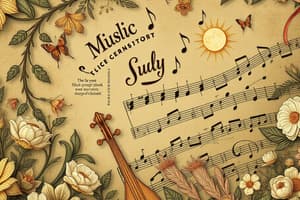Podcast
Questions and Answers
What does the term agitato signify in music?
What does the term agitato signify in music?
- Agitated (correct)
- With expression
- Slow tempo
- Return to original tempo
Ad libitum means that the performer must strictly follow the written notes.
Ad libitum means that the performer must strictly follow the written notes.
False (B)
What is the meaning of the term crescendo?
What is the meaning of the term crescendo?
becoming louder
In music, con brio means to play ___ vigor.
In music, con brio means to play ___ vigor.
Match the following terms with their meanings:
Match the following terms with their meanings:
What does alla indicate in a musical piece?
What does alla indicate in a musical piece?
The term andante suggests a very fast tempo.
The term andante suggests a very fast tempo.
What does the term calando refer to in music?
What does the term calando refer to in music?
The term con grazia suggests playing ___ grace.
The term con grazia suggests playing ___ grace.
Which term means to proceed without a break?
Which term means to proceed without a break?
What does the term 'fortissimo' (ff) refer to in music?
What does the term 'fortissimo' (ff) refer to in music?
The term 'vivace' means lively and brisk.
The term 'vivace' means lively and brisk.
What does 'piano, p' mean?
What does 'piano, p' mean?
The term __________ means to play the notes smoothly.
The term __________ means to play the notes smoothly.
Match the following expressive terms with their meanings:
Match the following expressive terms with their meanings:
What does the term 'marcato' mean in musical expression?
What does the term 'marcato' mean in musical expression?
The term 'largo' refers to a tempo that is very fast.
The term 'largo' refers to a tempo that is very fast.
What does 'sostenuto' refer to in music?
What does 'sostenuto' refer to in music?
The term __________ indicates a gradual increase in volume.
The term __________ indicates a gradual increase in volume.
Which term indicates that music should be played 'playful'?
Which term indicates that music should be played 'playful'?
'Molto' translates to 'much' or 'very'.
'Molto' translates to 'much' or 'very'.
What does 'pesante' mean in music?
What does 'pesante' mean in music?
The term __________ means to perform at a moderate tempo.
The term __________ means to perform at a moderate tempo.
Match the following tempo markings:
Match the following tempo markings:
What does 'dolente' express in music?
What does 'dolente' express in music?
Flashcards
accelerando
accelerando
becoming quicker
accent
accent
a stressed note
adagio
adagio
slow
allegretto
allegretto
Signup and view all the flashcards
allegro
allegro
Signup and view all the flashcards
andante
andante
Signup and view all the flashcards
a tempo
a tempo
Signup and view all the flashcards
crescendo
crescendo
Signup and view all the flashcards
da capo
da capo
Signup and view all the flashcards
ritardando
ritardando
Signup and view all the flashcards
diminuendo
diminuendo
Signup and view all the flashcards
dolce
dolce
Signup and view all the flashcards
forte
forte
Signup and view all the flashcards
piano
piano
Signup and view all the flashcards
fortissimo
fortissimo
Signup and view all the flashcards
pianissimo
pianissimo
Signup and view all the flashcards
legato
legato
Signup and view all the flashcards
staccato
staccato
Signup and view all the flashcards
mezzo forte
mezzo forte
Signup and view all the flashcards
mezzo piano
mezzo piano
Signup and view all the flashcards
Study Notes
Music Terms and Signs
- Terms: Music terms and definitions are listed, including tempo markings (e.g., adagio, allegro, andante), dynamics (e.g., forte, piano), and expressive directions (e.g., legato, staccato).
- Tempo Markings: Explain how various terms like accelerando (becoming quicker), ritardando (slowing down), and a tempo (return to the original tempo) affect the music's speed.
- Dynamics: Definitions showing how loud or soft music should be, such as forte (loud), piano (soft), and fortissimo (very loud).
- Expressive Directions: Explanations for terms about playing style, such as legato (smooth) and staccato(detached).
- Musical Symbols: Includes symbols that indicate tempo changes (e.g., accelerando, ritardando), dynamics (e.g., crescendo, diminuendo), articulation (e.g., staccato, legato), and other musical instructions.
Musical Signs
- Symbols for Dynamics: Symbols such as crescendo, decrescendo, and sforzando show changes in volume.
- Articulation: Symbols like staccato and legato indicate how notes should be played and what level of separation between notes is required.
- Tempo: Symbols and notations guide how fast the music should be played, including the directions for speed changes.
- Bowing Techniques: Symbols and notations demonstrate directions for using a bow for playing stringed instruments.
- Pedaling: Symbols explain how the use of pedals affects the tone. Pedal markings are included in the notations to show different pedal effects.
Studying That Suits You
Use AI to generate personalized quizzes and flashcards to suit your learning preferences.




